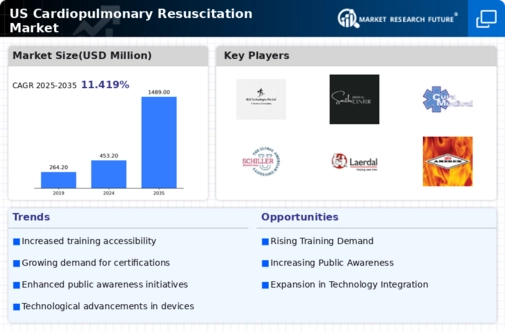Growing Awareness of CPR Importance
The increasing awareness regarding the significance of cardiopulmonary resuscitation (CPR) in saving lives is a crucial driver for the cardiopulmonary resuscitation market. Educational campaigns and initiatives by health organizations have highlighted the effectiveness of CPR in emergency situations. As a result, more individuals are seeking training and certification in CPR techniques. According to recent data, approximately 70% of adults in the US are aware of the importance of CPR, which has led to a surge in training programs. This heightened awareness not only encourages individuals to learn CPR but also promotes the adoption of CPR training in schools and workplaces, thereby expanding the cardiopulmonary resuscitation market. The focus on community health and safety further propels the demand for CPR training and resources.
Increased Focus on Workplace Safety
The growing emphasis on workplace safety is significantly influencing the cardiopulmonary resuscitation market. Employers are increasingly recognizing the importance of having trained personnel capable of responding to medical emergencies, including cardiac arrests. As a result, many organizations are implementing mandatory CPR training for employees, particularly in high-risk industries such as construction and manufacturing. This trend is supported by statistics indicating that workplaces with CPR-trained staff can reduce the risk of fatalities during emergencies. The cardiopulmonary resuscitation market is expected to benefit from this focus on safety, with projections suggesting a growth rate of around 20% as more companies invest in training programs to enhance employee safety and preparedness.
Rising Incidence of Cardiac Arrests
The alarming rise in the incidence of cardiac arrests is a critical driver for the cardiopulmonary resuscitation market. With heart disease remaining a leading cause of death in the US, the need for immediate and effective CPR has never been more pressing. Data indicates that approximately 350,000 cardiac arrests occur outside of hospitals each year, underscoring the necessity for widespread CPR training. This growing prevalence of cardiac emergencies is prompting individuals and organizations to prioritize CPR education and resources. Consequently, the cardiopulmonary resuscitation market is likely to experience substantial growth, as more people seek to equip themselves with the skills needed to respond effectively in life-threatening situations.
Legislative Support for CPR Training
Legislative measures aimed at promoting cardiopulmonary resuscitation training are emerging as a vital driver for the cardiopulmonary resuscitation market. Various states in the US have enacted laws mandating CPR training in schools and for certain professions, such as healthcare workers and first responders. This regulatory support not only increases the number of trained individuals but also fosters a culture of preparedness in emergency situations. As more states adopt similar legislation, the demand for CPR training programs is likely to rise. The market could see a potential growth of 15% in response to these legislative changes, as educational institutions and organizations seek to comply with new requirements and ensure that their personnel are adequately trained in CPR.
Technological Advancements in Training Tools
Technological innovations are transforming the landscape of the cardiopulmonary resuscitation market. The introduction of advanced training tools, such as virtual reality (VR) and augmented reality (AR), enhances the learning experience for CPR trainees. These technologies provide realistic simulations that allow individuals to practice CPR techniques in a controlled environment. Furthermore, mobile applications and online platforms are making CPR training more accessible, catering to a broader audience. The market for CPR training tools is projected to grow significantly, with estimates suggesting an increase of over 25% in the next five years. This trend indicates a shift towards more interactive and engaging training methods, which could potentially lead to higher retention rates of CPR skills among trainees.






















Leave a Comment